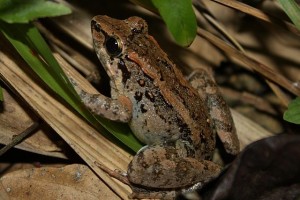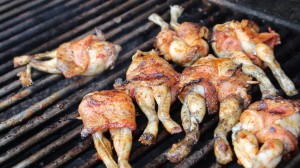I spent a couple of years living in the Philippines on Samar and Leyte. The Jungles were some of the most beautiful lush I’ve ever seen and the environment exposed me to a whole new range of exotic cuisine. While food can seem odd and non-appetizing in some regions of the world, this is hardly the case there; anyone who knows a philippino who has cooked for them will vouch for that statement.
The isolated little Leyte town of Calubian is where I first learned how to catch and prepare frogs as a delicious meal. This quant village is stretched out between the ocean and jungle covered mountains. Levi Cosmiano, a great guy and combat veteran of jungle warfare in Mindanao, taught us how to go up jungle streams at night and catch the little guys. In other locations, when the fields were flooded but not growing rice, it was also a happy hunting ground; but not so much rice was grown Calubian because of the terrain.
It didn’t take long to fill big sacks, and this is how we did it, but there are dozens of ways to prepare these things. Back at the home we immerse them in the bag momentarily in boiling water to kill them similar to crabs, and then we’d move onto the other preparations. I think we boiled them to kill them because they weren’t that large, and it was more economical than killing each one with a stab through the neck and spine, but at the time i didn’t ask because it was all new to me. These are some of the easiest creatures to prepare for eating; two slits on either side of the neck lets you twist and pull the head off with you pointer and middle finger, taking all the entrails with it. After that grab the skin at the nape of the neck and it peels off inside out like clothing; if you feel so inclined you can also cut that hands and feet off. At this point we used to marinade them overnight in a teriyaki style sauce to make a great meal the next morning. You can find hundreds of recipes on line with a quick search so I’m not going to waste your time with any; that, and I’m honestly not that great of a cook.
Most of the meat is in the legs, but cooking them as a whole give you bits of back and forelegs that can be stripped of meat; that’s why most places that serve frogs only serve the legs, there’s usually not enough on the rest to bother with. If you are curious, all frogs are edible, even bull frogs. The toxins of some frogs will always be in the skin, so even a toad can be eaten if the skin is removed. Many frogs aren’t considered edible simply because they are two small to bother with. The bullfrog is the largest species of frog in the US and has been introduced to other parts of the world because it is adaptable and edible.
Handle these animals in the same way you would raw chicken, because they carry many of the same potential illnesses. Frogs often have salmonella and many other bacteria in their skin; another reason to remove it, especially if you are not familiar with that particular variety. Cook these thoroughly like you would chicken or pork. While most are tasty, some varieties can be quite awful; but still provide nutrients. I understand the leopard frog that we see around here in Idaho is pretty poor eating.
Depending on how you cook frogs they are very low in Saturated Fat. They are also a good source of Thiamin, Riboflavin, Iron, Phosphorus, Potassium and Copper, and a very good source of Protein and Selenium. The downside is they are high in Cholesterol. Look up a recipe, find out what frogs in your area are worth eating, and give it a shot.
Jon



Leave a Reply